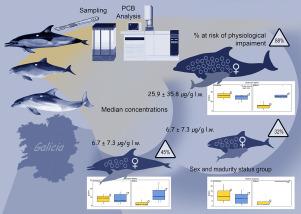在加利西亚(西班牙)、东北大西洋搁浅的三种鲸类动物中多氯联苯(PCBs)的监测水平
IF 4.9
3区 环境科学与生态学
Q1 ENVIRONMENTAL SCIENCES
引用次数: 0
摘要
尽管对多氯联苯等有机污染物的生产和使用规定越来越多,但它们继续对海洋生物构成威胁。齿鲸类由于其捕食者的角色和较长的预期寿命,对多氯联苯的积累和生物放大非常敏感。因此,评估鲸类中多氯联苯的水平对于评估其个体和种群水平的健康状况以及提供生态系统健康指标具有重要意义。本研究分析了西班牙西北部(东北大西洋)三种最常搁浅的齿齿动物:普通海豚(Delphinus delphis) (n = 42)、宽吻海豚(Tursiops truncatus) (n = 17)和港海豚(Phocoena Phocoena) (n = 19)的鲸脂中多氯联苯的浓度。个体浓度范围从0.32到160.74 μg/g脂质重量(l.w., Σ14PCBs),到目前为止,在宽吻海豚中观察到的水平最高(中位数浓度是其他物种的三倍)。许多观测值超过了这些物种的商定阈值(17 μg/g l.w,以Aroclor 1254等效浓度表示)。这表明,尽管全球环境水平明显下降,但所分析的个体中仍有很大比例面临多氯联苯的风险。分析的三个物种代表了东北大西洋的一个关键地区,代表了不同的营养和栖息地生态位。定期监测鲸类物种的污染物水平对于遵守立法要求和对这些种群及其生态系统进行评估是必要的。本文章由计算机程序翻译,如有差异,请以英文原文为准。

Monitoring levels of polychlorinated biphenyls (PCBs) in three cetacean species stranded in Galicia (Spain), NE Atlantic
Despite increasing regulations on their production and use, organic pollutants, such as polychlorinated biphenyls (PCBs), continue to pose a threat to marine life. Odontocete cetaceans are highly susceptible to the accumulation and biomagnification of PCBs due to their role as predators and long life expectancy. Therefore, assessing the levels of PCBs in cetaceans is important to evaluate their health status at the individual and population levels, as well as to provide an indicator of ecosystem health. In the present study, concentrations of PCBs were analysed in the blubber of the three most frequently stranded odontocete species in NW Spain (NE Atlantic): common dolphin (Delphinus delphis) (n = 42), bottlenose dolphin (Tursiops truncatus) (n = 17) and harbour porpoise (Phocoena phocoena) (n = 19). Individual concentrations ranged from 0.32 to 160.74 μg/g lipid weight (l.w., Σ14PCBs), with the highest levels observed, by far, in bottlenose dolphins (the median concentration was three times higher than that of other species). Many observed values exceed the agreed threshold value for these species (17 μg/g l.w., when expressed as the Aroclor 1254 equivalent concentrations). This suggests that a high percentage of the individuals analysed are at risk from PCBs despite an apparent global decrease in environmental levels. The three species analysed are representative of a key area of the NE Atlantic and represent different trophic and habitat niches. Regular monitoring of pollutant levels in cetacean species is necessary for compliance with legislative requirements and to allow the assessment of these populations and their ecosystems.
求助全文
通过发布文献求助,成功后即可免费获取论文全文。
去求助
来源期刊

Marine pollution bulletin
环境科学-海洋与淡水生物学
CiteScore
10.20
自引率
15.50%
发文量
1077
审稿时长
68 days
期刊介绍:
Marine Pollution Bulletin is concerned with the rational use of maritime and marine resources in estuaries, the seas and oceans, as well as with documenting marine pollution and introducing new forms of measurement and analysis. A wide range of topics are discussed as news, comment, reviews and research reports, not only on effluent disposal and pollution control, but also on the management, economic aspects and protection of the marine environment in general.
 求助内容:
求助内容: 应助结果提醒方式:
应助结果提醒方式:


